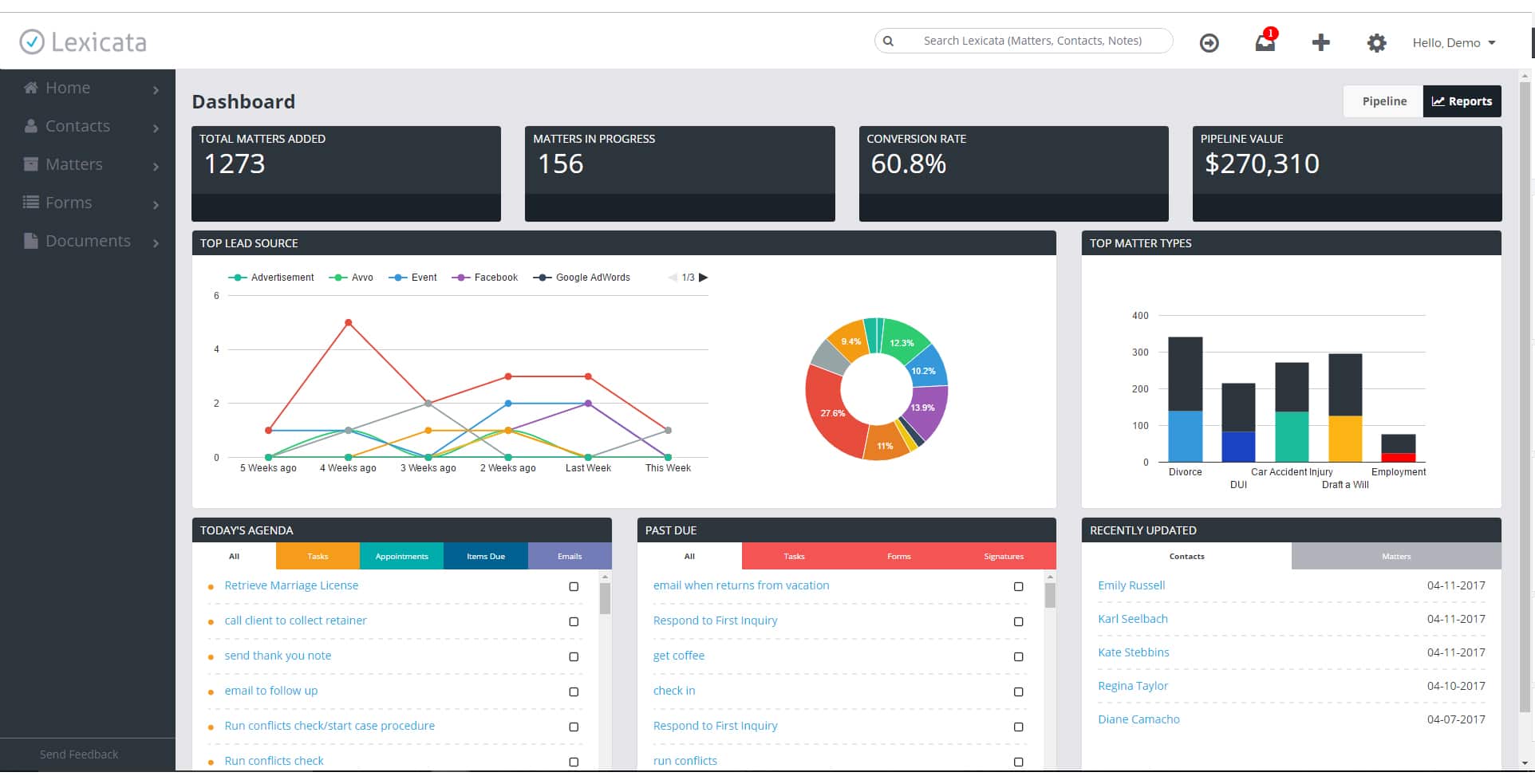Legal technology has advanced light years over the span of the last decade-plus. And, as the originally successful innovators have had large corporations grow up around them, new innovators like Lexicata, have started to poke around in the dustier corners of the legal technology ecosystem — with more willing investors in tow.
Currently, entrepreneurs are developing systems focused on more specific business applications. By way of example, traditional document automation tools are moving into the cloud, and new document automation programs are growing up in the cloud.
Until recently, law firms have had to rely on generic business software for managing customer relations, including intake. Salesforce is the longtime leader in that category. Starting with Avvo’s release of Ignite, however, law firm-specific choices have become available. One of the latest entries, Lexicata, built by LawKick co-founders Michael Chasin and Aaron George, represents an important step forward in this segment.
What’s CRM? (Canines Roaming Menacingly?)
Before jumping into what Lexicata does, it makes sense to define what a CRM is, since many lawyers are still unsure. If you already know, skip to the next section —if you don’t, here’s your primer.
A customer relationship management (CRM) tool essentially tracks intake. It is a way to manage the process for converting a potential client to an actual one. CRM allows you to track your communications with a potential client (via a number of different methods) from initial contact to engagement agreement. With CRM software, you can assign and manage tasks surrounding that process, as well as develop specific workflows about how you convert leads. Reporting tools define your success rate in terms of client conversions.
Most law firms operate in that nethersphere between “lead” and “engagement” in an aggressively ad hoc fashion. CRM software grants the ability to attach real numbers to your efforts. You can then make changes to the process, to better capture more of the leads you acquire and turn them into paying clients. Using data in this way is a clear competitive advantage.
Lawyers often conflate the use of CRM software and LPM (law practice management) software, but in most cases, there is a clear dividing line: CRM manages the lead to client process, and LPM takes over for the management of the attorney-client relationship. In other words, a CRM product helps you to birth the attorney-client relationship, while LPM software nurtures it.
Lexicata Is What You Make It
Lexicata offers all the major features of CRM software, and then some. Its dashboard allows you to easily aggregate tasks and events surrounding lead management, including consultations. Lexicata’s “inbox” is not an actual email inbox. Think of it as a holding tank for the leads you acquire from various third-party sources (your virtual receptionist, your website, your lead generation service), on which leads you will take action, through Lexicata. Those leads are reviewed and then added to the intake pipeline. Pre-constructed labels allow you to tag contacts for status: intake, hired, did not hire. Sub-labels give you the ability to tag for further clarity (so you can define why a client did not hire the firm, for example).
An agenda view shows your upcoming schedule in relation to lead management.
Having access to a program chock-full of features is great, but most lawyers only use a handful of the features available in any given software. Lexicata’s creators are obviously acutely aware of this, as the program offers helpful and comprehensive guidance at every turn — both within the program itself and through a robust Help Center that includes text, screenshots and video tutorials.
However, even without the help features, Lexicata is intuitive in the extreme. Even a novice technology user can cruise through the setup, and most of the applications. Adding to Lexicata’s usability is that it is highly customizable. While the default settings represent sufficient components for a successful CRM program, almost everything in Lexicata is editable, which means that Lexicata can be converted to a CRM product that is even more directly tailored to your needs.
Lexicata also integrates with a number of other programs such as email services and virtual receptionists, many of which relate back to law firm communications in some fashion. At this point, the only CMS integration is for WordPress, and the only practice management integration is for Clio. However, I suspect the integration options will increase.
The Things I Like about Lexicata
Lexicata is a thoughtfully constructed product, and there are three things I like the most:
1. You can build — and execute — branded intake forms and agreements. You upload your logo and information and Lexicata spits out a letterhead (or header) for you. You can send the branded intake form to your potential clients to complete or you can use it for in-office intake, potentially as a guide for your receptionist. You can include instructions for completing forms, and limited form logic is available, including for question branching. But, the LEGO-style fun does not stop there. You can also create (via text or PDF editor) and send engagement agreements and fee agreements through Lexicata. An integration with HelloSign, included with Lexicata for free, completes the package, allowing you to acquire e-signatures for the documents you send out.
2. Valuable reports define things like conversion rate and pipeline value. Your pipeline value can provide sufficient motivation to get you to increase your conversion rate. You can also filter for your top lead sources, as well as for top matter types. The former is useful in constructing your outreach, the latter in defining your niche.
3. I can appreciate that Lexicata is able to introduce the concept of an intake process into law firms, potentially for the first time. As I alluded to earlier, solo and small firms lack in processes, which decreases efficiency and negatively affects the bottom line. Using a CRM forces the law firm to implement at least some notion of process into its business culture. As for those lawyers who come to value an intake process, certainly, they can find other corners of the dark law firm environment to better structure.
Capable (of) Reviving (Your) Marketing?
Law firm-centric CRM software is still a relatively new thing, but Lexicata’s version is absolutely the most comprehensive stab at it to date. If it’s true that a CRM product, fully realized, is capable of reviving a business’s marketing efforts, it’s probably worth a look.
You can book a demo here. And, for a $50 discount on an annual subscription, you can use the code “HeWenttoJared.” (Full disclosure: I have no affiliate relationship with the company.)
For more on client intake, listen to my interview with Michael Chasin on Legal Talk Network.
Related: The Long Nine: Essential Software for the Modern Law Practice, by Jared Correia
Illustration ©iStockPhoto.com
Subscribe to Attorney at Work
Get really good ideas every day: Subscribe to the Daily Dispatch and Weekly Wrap (it’s free). Follow us on Twitter @attnyatwork.
























